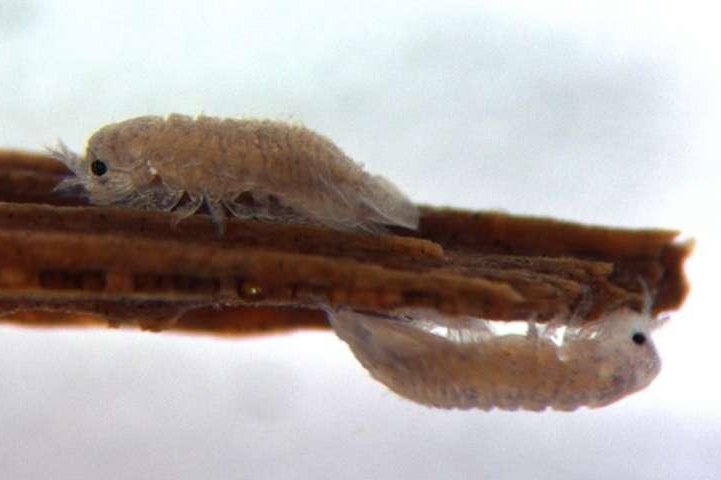Gribble use special proteins in the guts to break down lignin, allowing them to extract sugar from bits of wood. Photo by Claire Steele-King and Katrin Besser/University of York
Dec. 3 (UPI) -- Researchers have figured out how a tiny crustacean breaks down lignin and extracts sugar from wood. The revelation could help scientists develop cheaper, more efficient ways to turn wood into biofuel.
Gribble are small marine isopods that bore into wood and plant material. Though gribble species mostly bore into and eat seaweeds, seagrasses and driftwood, they can also act as a nuisance, chomping on boat hulls and eating the wood posts of jetties and piers.
Until now, scientists weren't sure how the invertebrates break down lignin, the tough strands that lend wood its strength. An examination of the crustacean's digestive system revealed the presence of proteins called hemocyanins.
Hemocyanin carries oxygen in the blood of invertebrates, just as hemoglobin does in animals. Hemocyanin uses copper atoms to bind with oxygen, causing the blood of invertebrates to appear blue in color.
As the new research revealed, oxygen's powerful oxidative properties help break down lignin bonds inside the guts of gribbles.
In the lab, scientists replicated the process, treating wood samples with hemocyanin, before extracting sugars. When treated with the novel proteins, the samples released twice as much as sugar. The effect is similar to a variety of thermochemical pre-treatments used in commercial wood processing.
"Gribble are the only animal known to have a sterile digestive system," Simon McQueen-Mason, biology professor at the University of York, said in a news release. "This makes their method for wood digestion easier to study than that of other wood-consuming creatures such as termites, which rely on thousands of gut microbes to do the digestion for them."
"We have found that Gribble chew wood into very small pieces before using hemocyanins to disrupt the structure of lignin," McQueen-Mason said. "GH7 enzymes, the same group of enzymes used by fungi to decompose wood, are then able to break through and release sugars."
Researchers think their findings -- published this week in the journal Nature Communications -- will help energy companies more sustainably convert woody plant biomass into renewable biofuels.
"In the long term this discovery may be useful in reducing the amount of energy required for pre-treating wood to convert it to biofuel," biology professor Neil Bruce said.
Not everyone sees biofuel production as a solution to climate change and the economy's reliance on fossil fuels.
Many climate critics argue wood-based fuels are a threat to forests, which store much of the world's carbon reserves.
"Globally, if the world were to supply only an additional 2 percent of its energy from wood, it would need to double commercial wood harvests around the world with harsh effects on forests," Tim Searchinger, author of the new paper and a researcher scholar at Princeton University's Woodrow Wilson School of Public and International Affairs, said earlier this year.
It's true that wood regrows, scientists acknowledge, but in the short-term, large amounts of carbon will be released, as wood is burned for fuel and stumps left behind to decompose. Trees grow slowly. The burning of wood fuel will release carbon into the atmosphere almost immediately.
Even efficient biofuel production still results in carbon emissions. Many climate scientists argue policy makers need to prioritize the preservation of carbon-storing materials, not encourage their conversion into fuels.
"Current policies advancing bioenergy contribute to the pressure to convert natural land into harvested forest or cropland," John M. DeCicco, a research professor at the University of Michigan Energy Institute, said earlier this year. "But high quality land is a limited resource. For reducing atmospheric CO2, the most efficient use of ecologically productive land is to leave it alone, or reforest it. Let it act as a natural, long-term carbon sink."















